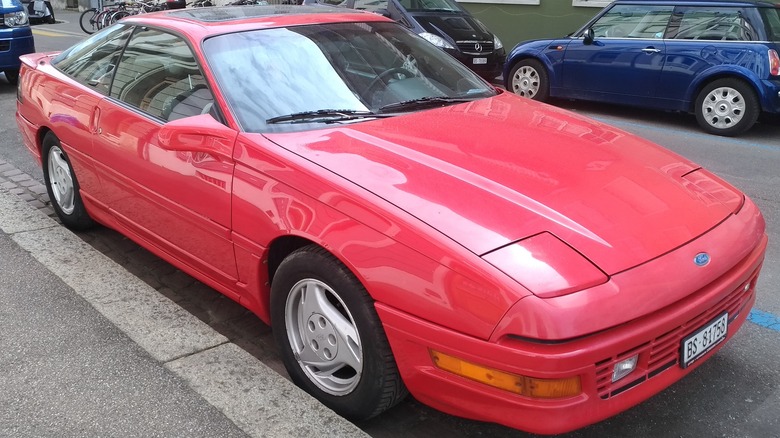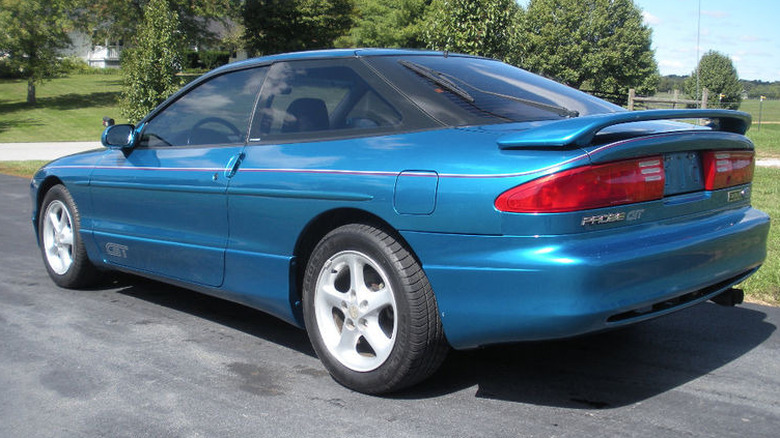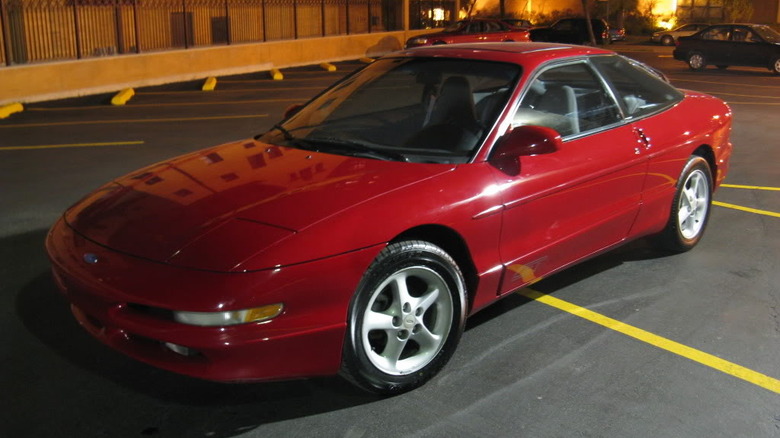Ford Probe Gen 1 Vs Gen 2: How They Differ (And Which One's Faster)
Ford's first big hit was the Model T, thanks in large part to the four-stroke, four-cylinder engine that powered it. In the century-plus since that industry icon went out of production, Ford has also brought us the long-lived Mustang, the absolutely gorgeous late-'50s Thunderbird, and the immensely popular F-series pickup truck. By the early '80s, Mustang sales were dropping, a slump Ford misguidedly pinned on the model's old-school solid rear axle and pushrod V8. Ford began developing a replacement for the Mustang, but fans of the legendary pony car rallied to save it with an equally old-school letter-writing campaign.
Ford was too far along with the new model's development to simply scrap the design, so it put a new badge on the Mustang's erstwhile replacement and unveiled the Probe at the 1988 Chicago Auto Show. It went into production for the 1989 model year and got a major update in 1993. Soon after, the Probe began to lose market share to an influx of zippy, slick-handling compacts from other carmakers. The Mustang's fourth-gen redesign in 1994 also siphoned off some corporate attention, and with it went potential Probe buyers. By 1997, Probe sales had dipped to just over 15,000 units (via Driving Line), even though Ford started selling the model in Europe, Asia, and Oceania. Let's take a look at the differences between the two generations of Probe and see which one is the better choice for performance-minded buyers.
[Featured image by Guillaume Vachey via Wikimedia Commons|Cropped and scaled|Public Domain]
Ford teamed with Mazda to make the Probe
The base engine in the Probe's first year was a 2.2 liter, four-cylinder Mazda powerplant that produced 110 horsepower. Ford leaned heavily on its partnership with Mazda in building the Probe. Along with the borrowed four-banger, the Probe shared a platform and Flat Rock, Michigan plant with the Mazda MX-6. In GT trim, the Probe came with a turbocharged four that put out 145 horsepower and 190 lb-ft of torque. The Probe GT was capable of a seven-second 0-60 sprint and a top speed of 131 miles per hour, and could cover a quarter mile in 15.3 seconds and corner at up to .85g.
Those numbers didn't quite match the '89 Mustang GT's benchmarks of 6.5 seconds, 15 seconds flat, and 142 miles per hour, but the Mustang had a V8 that was more than twice the size of the Probe's engine at 5.0 liters. The 1992 Probe was the last of the first generation and was offered in three trim levels: the naturally aspirated GL, the turbocharged GT, and the LX, which had a 3.0-liter V6 that put out 145 horsepower and 165 lb-ft of torque. While the LX's 0-60 and 1/4-mile times of 9.1 and 16.8 seconds were slower than the GT's, its top speed was three ticks faster at 134 miles per hour.
[Featured image by FPGT24 via Wikimedia Commons|Cropped and scaled|CC-By 3.0]
The two generations of Probe GT deliver roughly equal perfomance
Ford ditched the LX version of the Probe when it updated the model for 1993. The GT's motor was updated to a 2.5-liter V6 that produced 164 horsepower and 156 lb-ft of torque. That motor slung the 2,894-pound coupe from 0-60 in seven seconds flat, down the quarter-mile strip in 15.5 seconds at 89 miles per hour, and to a top speed of 133 mph. It pulled .86g on the skidpad, all while delivering 21 miles per gallon in the city and 26 on the highway.
The second-generation base model was powered by a 2.0-liter inline four that put out a more modest 115 horsepower and 124 lb-ft of torque, making this version a decidedly less exciting performer. It took a tick under ten seconds to get to 60 miles per hour and 17.4 seconds to cover a quarter mile, and was only capable of a top speed of 121 miles per hour. Its 24.5 miles per gallon combined fuel economy was comparable to the GT version, even though it weighed 275 pounds less than the GT.
The first and second-generation Probe GT models turn in more or less identical performance numbers. Their 0-60 sprint times and top speeds are the same, and the 1st-gen version was just two tenths of a second quicker over a quarter mile. Peak production was in the first year at just under 163,000 units, and by the end of the Probe's run that had fallen to less than 17,000.
[Featured image by FPGT24 via Wikimedia Commons|Cropped and scaled|CC-By 3.0]


